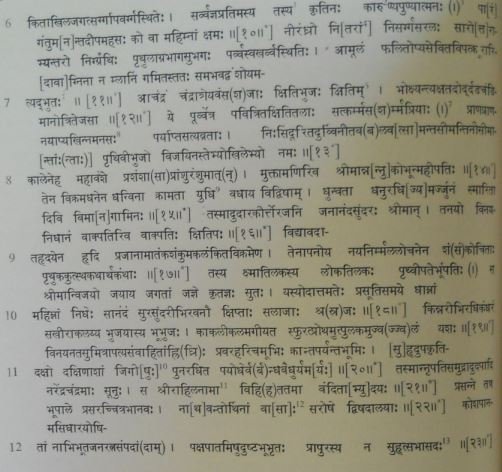|
INSCRIPTIONS OF THE CHANDELLAS OF JEJAKABHUKTI

_____________________________
[1] Reading conjectural and as required by the context. In the original these two aksharas look like  . .
[2] Probably some other letter was originally cut and it was later on altered to 
[3] The daṇḍa is redundant.
[4] Nothing that this akshara look like  Kielhorn proposed to correct it to Kielhorn proposed to correct it to  to suit to the
sense, but the anusvāra on the third letter, which appears as r with its v-like form, as at many places
in the inscription, tempts me to take the whole word as to suit to the
sense, but the anusvāra on the third letter, which appears as r with its v-like form, as at many places
in the inscription, tempts me to take the whole word as  , with the second of the aksharas misformed. The reading proposed by me would also be suitable to the sense. , with the second of the aksharas misformed. The reading proposed by me would also be suitable to the sense.
[5] By play on words, the expressions used in this verse are applicable to vaṁśa, meaning (1) family and
(2) bamboo.
[6] This hemistich is metrically faulty. It may be restored as 
[7] The punctuation mark, as some others below, is superfluous; and not noting them separately in each
case, I have put them in brackets. Kielhorn read the two of the preceding aksharas as sargga and
noted that the second of these letters is rather -rmma than -rgga. I think that mma is really intended
here in the sense of ‘having happiness by righteous conduct’.
[8]  , which was originally omitted, was added subsequently in a smaller form below the line and the
dots of the visarga that follows are combined with the daṇḍa. , which was originally omitted, was added subsequently in a smaller form below the line and the
dots of the visarga that follows are combined with the daṇḍa.
[9] Originally two dots, later on changed to the curve of the medial i. Here we can have the pada-chchhāda
as krāmatā or ākrāmatā, walking (proceeding), or attacking.
[10] The consonant of this akshara looks like n, and the fore-limb of the preceding akshara looks somewhat
like v, because of a redundant chisel stroke.
[11] The consonant of the first letter of the name is cut as ch, and of the bhyu that follows appears a gt.
probably with a medial u. Saḥ is here in the sense of ‘renowned’.
[12] These aksharas are misformed and in the impression they look like  . But I fail to see
the mark above the last of these which Kielhorn, with some hesitation, supposed to be intended for śa. . But I fail to see
the mark above the last of these which Kielhorn, with some hesitation, supposed to be intended for śa.
[13] The seventh akshara of this verse is engraved as dhā and Kielhorn corrected it to vā, giving the went
vārayōshitām. He also translated the verse, for which see the text, f.n. 32.
|